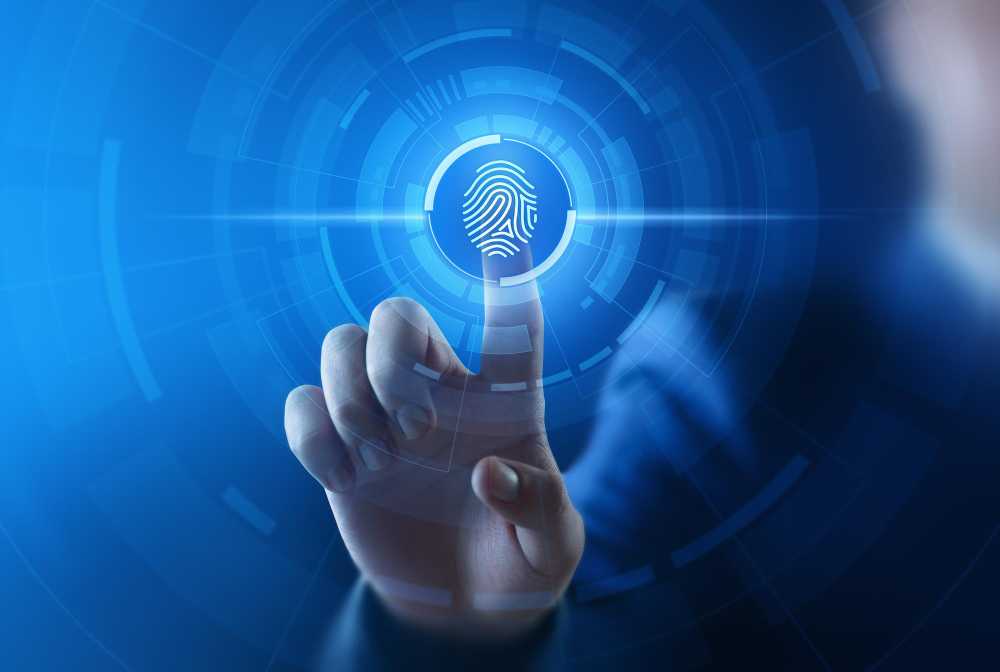Biometric technology uses something you have—your fingerprint, eyeballs, or face—to identify and verify your identity. It offers a higher level of security and accuracy* than passwords, badges, and documents.
Financial services companies are integrating fingerprint scanners into mobile banking apps. Retailers are experimenting with facial recognition to track customer movements and promote targeted ads, as well as iris or palm scanning for checkout-free shopping.

1. AI-Based Authentication
Biometrics were developed first and foremost for accurate identification and verification, but they have evolved into other use cases, from security to convenience. For example, fingerprint and facial recognition can eliminate the need for passwords to access computers or phones, or enter restricted rooms and buildings storing pharmaceuticals and sensitive equipment. These technologies can also be used to identify individuals at crime scenes.
Liveness detection is another powerful new feature of biometrics. It uses machine learning to differentiate digital or artificial images and sounds from those captured in the moment by a physically present person, to determine authenticity. In this way, liveness detection can prevent bad actors from using spoofed video or audio to gain access to secure data.
Behavioral biometrics, such as gait analysis or keystroke dynamics, can also be used to verify identity. For example, by analyzing an individual’s typing and mouse movements, behavioral biometrics can determine if they are attempting to login from a different location or device than usual.
Another exciting new application for biometrics is touchless, or frictionless, authentication. Apple’s Touch ID, for instance, makes mobile POS payments more secure by verifying a user’s identity without the need to scan a physical card or enter a PIN. In addition, retailers are now trialing checkout-free stores where customers simply collect the goods they want and leave without paying.
2. Biometric Identity Verification
If a company uses biometrics to verify identities, then they are able to prevent users from accessing sensitive information, even if they have control of the device or home internet connection. This is why many companies are beginning to use facial recognition for authentication as a way to stop unauthorized access. The technology can be used to scan a user’s face in real-time, making it impossible for anyone else to log into their account or access data.
A good example of this is how banks are using biometrics to verify customers’ identities. They might collect a passport photograph, fingerprints or voice data when a customer opens an account. This is then used in the future when they want to access their bank account or to make a payment.
In addition to this, banks are also using the technology to reduce fraud in transactions and enhance customer convenience. They are also incorporating biometrics into their mobile banking apps and using them as an alternative to PINs or passwords. For instance, Seven Bank in Japan has begun to use the iPhone’s Touch ID for ATM logins.
Biometrics are also being deployed in the sharing economy, such as in ride-sharing apps, where it is used to verify the identity of drivers and passengers. This is a vital part of preventing identity fraud and enabling the sharing economy to continue to grow.
4. High-Security Biometrics
As technology progresses, the need for faster, scalable, secure authentication solutions grows. Biometrics meet these needs, with technologies that are more practical and user-friendly than ever.
For example, facial recognition is becoming popular as a form of identity verification in customer service calls. It’s also a common feature on smartphones. It allows people to access their devices and apps without needing to type a password or swipe a pin. Facial recognition can even be used for e-banking and e-commerce transactions, allowing people to confirm their identity quickly and conveniently.
In addition, some forms of biometrics are harder to fake than other forms. This is why they’re a popular form of security for military and law enforcement use. Ruggedized mobile devices can capture fingerprints, iris, and face data in the field to verify soldiers and other personnel. This prevents people with criminal records or fraudulent identities from entering tactical environments where they could pose a threat to safety and property.
While it’s important to note that biometric data can still be stolen or hacked, the industry is working on methods of secure storage and more robust detection systems. These methods will help prevent hackers from spoofing fingerprint, iris, or facial data. They will also prevent false positives and negatives that can occur when a person’s information is shared or sold to third parties without their consent.